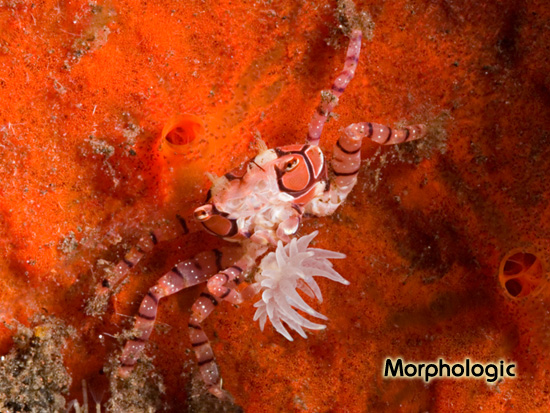Creature Feature: Boxer Crabs

Pictured here is our pal Boxer Crab. He has lived in the BioCube 8 for almost a full year now. In that time he (she?) has molted about 6 times that we’ve noticed. We keep a collection of these molts on the kitchen window sill so we can track his growth (maybe 50% larger, but now probably full grown).
The boxer crab (Lybia tesselata) is aptly named because it carries around two tiny anemones (Bunodeopsis sp.) on it’s front claws. It wields these anemones in a boxer’s pose when threatened. It will also use the anemones to drag across the substrate, using the anemones as little “food magnets”. Any food item touched will adhere to the anemones’ stinging nematocysts. This association between boxer crab and the anemones is a classic case of symbiotic mutualism, where both animals benefit from their association.
In the crab’s case, it benefits from the stinging powers of the anemone in both hunting and defense. The anemone benefits from the relationship by being carried to food sources and protection by the swift moving crab. But beyond “simple” mutualism, this association demonstrates a crab utilizing the anemones as a tool! One has to scratch one’s head as to imagine how this “intelligent” relationship developed. How does a newly settled boxer crab baby know how to seek out this specific anemone species???
Boxer crabs hail from the Indo-Pacific, where they live underneath stones and coral rubble, making them very easily overlooked by the casual diver. I have spent hours in Indonesia in shallow water, simply turning over stones looking for them in order to take the perfect “whatchoo lookin’ at?” pose that these comical crabs like to give when they are threatened. However, I discovered very quickly that when I would finally find one under a rock, they would scurry away much faster than the debris and silt settled (thus obscuring a clear photo)…
I later discovered that this species seems more active at night, as I was able to encounter them on night dives when they were more boldly exploring.

This one-armed boxer crab was boldly hunting in the open at night in Tulamben, Bali in about 30 feet of water. When it regrows it’s other claw, will it find a new anemone, or “frag” it’s remaining one?
Based on our experience, boxer crabs make exceptional pets in the nano aquarium. I would only recommend that you house them in a tank less than 10 gallons though, as you may have difficulty observing them in a larger reef tank. They tend to be quite cryptic, preferring the protection of a cave or crevice in the live rock. Once they find a nook that suits them, they tend to make it a preferred hangout where you can reliably find the critter time after time.
The only time that I see our Boxer friend leave his hideout is when food is added to the aquarium. He has pretty keen olfactory senses, and quickly locates any food particles added.
Unlike an anemone hermit crab, the boxer crab physically holds onto it’s anemones with it’s front claws. Therefore, when it molts it has to put the anemones down, only to pick them back up again after molting.
The anemones are clearly very hardy to have survived the stresses of collection and shipping. Since they are white, I will assume that they are non-photosynthetic, and therefore reliant on the same foods that the crab eats. The anemones have not grown in size since the day we added the crab to the tank. I am not sure what sort of a life these anemones have when they aren’t being utilized by a boxer crab. I have never seen them free-living in the wild (although they are very tiny). I’d be interested in reading any studies on this symbiosis, as I have a lot of questions…
How does the crab first find it’s anemones?
What happens to the anemones if the crab dies? Can they live without the crab?
If the crab loses a claw/anemone, can it “frag” it’s other anemone to regenerate a new “boxing glove”?
